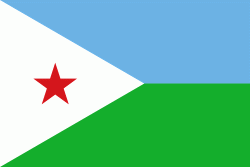Flag of Djibouti
The national flag of Djibouti (Calanka Jabuuti, علم جيبوتي, Drapeau de Djibouti) is a horizontal flag bicolor with equal bands of light blue and light green, with a white, equilateral triangle at the hoist. In the center of the triangle is a red star. The flag combines the basic layout and colors from the flag of the Front de Libération de la Côte des Somalis. The light blue represents the sky and the sea, as well as the Somalis, green represents the everlasting green of the earth, as well as the Afars, white represents the colour of peace and the five point red star represents unity, the blood shed by the martyrs of independence, as well as Djibouti being one of the five regions inhabited by the Somali people.
Beginning in the mid-19th century before the establishment of the French Somaliland, other flags were used as the flag of the Ottoman Empire, Sultanate of Tajoura and as well religious flags. During the French Somaliland and French Territory of the Afars and the Issas, the only ensign used was the tricolor. The flag was created and designed by the Front for the Liberation of the Somali Coast (FLCS) as the party official flag in the 1960s, which was guerrilla group who fought for the independence of Djibouti from France. With the help of Ligue Populaire Africaine pour l'Indépendance (LPAI) to independence in 1977. The Djiboutian flag was raised for the first time upon independence on 27 June 1977, by the head of police Yacine Yabeh Galab. It is today flown on many governmental buildings.
Beginning in the mid-19th century before the establishment of the French Somaliland, other flags were used as the flag of the Ottoman Empire, Sultanate of Tajoura and as well religious flags. During the French Somaliland and French Territory of the Afars and the Issas, the only ensign used was the tricolor. The flag was created and designed by the Front for the Liberation of the Somali Coast (FLCS) as the party official flag in the 1960s, which was guerrilla group who fought for the independence of Djibouti from France. With the help of Ligue Populaire Africaine pour l'Indépendance (LPAI) to independence in 1977. The Djiboutian flag was raised for the first time upon independence on 27 June 1977, by the head of police Yacine Yabeh Galab. It is today flown on many governmental buildings.
National flag
Country - Djibouti
Warning: getimagesize(/Image/Map/MP223816.gif): failed to open stream: No such file or directory in /home/mapnlee7/public_html/MAPNALL/article.php on line 532
 |
 |
In antiquity, the territory, together with Ethiopia, Eritrea and Somaliland, was part of the Land of Punt. Nearby Zeila, now in Somaliland, was the seat of the medieval Adal and Ifat Sultanates. In the late 19th century, the colony of French Somaliland was established after the ruling Dir Somali sultans signed treaties with the French, and its railroad to Dire Dawa (and later Addis Ababa) allowed it to quickly supersede Zeila as the port for southern Ethiopia and the Ogaden. It was renamed the French Territory of the Afars and the Issas in 1967. A decade later, the Djiboutian people voted for independence. This officially marked the establishment of the Republic of Djibouti, named after its capital city. The new state joined the United Nations. In the early 1990s, tensions over government representation led to armed conflict, which ended in a power-sharing agreement in 2000 between the ruling party and the opposition.
